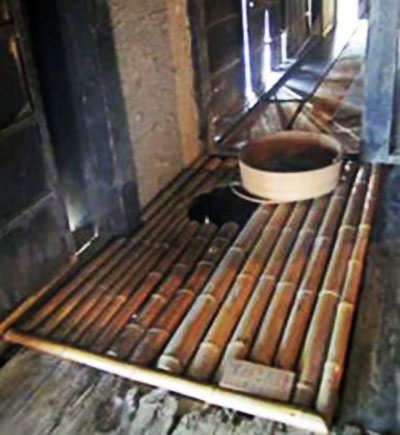

札幌が大雪に見舞われて必死の雪かき作業に追われる中、
世界ではロシアによるウクライナ侵略が公然と行われるおぞましい事態。
ロシアは北海道が隣接して向き合っている国。
こういう侵略国が平然と存在し、隣国にあるのが冷厳たる現実。
推移には目が離せないところですが、この事態がどういう影響を及ぼしていくか
世界は一挙に不透明な領域に入ってきたと思います。
とくにエネルギー問題は相当の影響を受けることは間違いがない。
欧州はロシアのガスパイプラインがエネルギーの生命線。
洋上風力だ、太陽光発電だと将来安定性の不透明な脱炭素に依存を強めた結果、
その不確実性、予測不可能性に翻弄され、その足下を冷酷に計算したロシアは
天然ガスという生命線、生殺与奪権を掌握し露骨な国益貫徹の戦争を仕掛けてきた。
自由主義世界はこのロシアの無法に対してどう立ち向かえるのか、
第2次大戦後の国連体制ではこの国が「常任理事国」だという現実。
戦後という虚構がガラガラと崩壊に向かう可能性も高まる。
自衛が危うい日本の国家体制もはげしく揺さぶられていると言えますね。
ということで落ち着きませんが、どんな時代でも命は繋いでいかなければならない。
四国の住環境探訪シリーズ、淡々と継続していきたいと思います。
きのう書いた「落とし込み構法」の追記です。
梁や指物に穴を開けて上から柱を落とし込んで固定させており、
「こき」とも呼ばれるこの地方独特の構法。1間毎に柱を立てている。
写真上の様子を参照ください。室内壁が無いので梁組を強固にして建物を支える。
その梁も長大で野太いものが使われており豪壮で力強い空間構成。
いずれの部屋も壁や天井板が無く屋根裏が丸見えで、構造体が剥き出し。
2枚目の写真では右側土間寄り中央にカマドを設けてある。
さらにその火力にプラスして囲炉裏も装置されていて、
居間兼食堂として使われていたようです。
これだけの火力集中ですが、正面に見える板外壁の素寒貧さはすごい。
この家は急峻な標高1000m程の急勾配の山間部に建てられたものの移築で、
冬の寒冷に対してこれで立ち向かっていたと考えると怖ろしい。
山間でバイオマス原料は比較的容易に獲得できる環境とはいえ、
暮らしのきびしさは視覚的にも十分に伝わってあまりある。
手前側に寝所スペースがあって、食事後の動線配置もわかりやすい。
暮らしぶりが具体的に見えてくる。


こちらの写真は竹簀の子敷きの「流し」で、
移築された環境でも、対面側の外部には流水が流れていましたが、
あるいは山間の移築前の土地でもそういう環境にあったのかもと思われました。
カマド、囲炉裏、流しと生存装置の配置ぶりを見ると興味深いですね。
English version⬇
[Tokushima Kenzan Slope / Kijishi’s Life ② Shikoku Living Space Exploration-14]
While Sapporo was hit by heavy snow and was busy shoveling snow,
The horrifying situation in which Russia’s invasion of Ukraine is openly carried out in the world.
Russia is a country where Hokkaido faces each other.
The reality is that such an invading country exists calmly and is in a neighboring country.
Keep an eye on the transition, but what kind of impact will this situation have?
I think the world has entered an uncertain territory all at once.
There is no doubt that energy problems in particular will be significantly affected.
In Europe, Russia’s gas pipeline is the lifeline of energy.
As a result of increasing dependence on decarbonization, which is uncertain about future stability in offshore wind power and solar power generation,
Russia, which was at the mercy of its uncertainty and unpredictability, ruthlessly calculated its feet
He has seized the lifeline of natural gas and the right to kill and kill, and has launched a blatant war of national interests.
How can the liberal world confront this Russian lawlessness?
The reality is that this country is a “permanent member” in the UN system after World War II.
There is also a high possibility that the post-war fiction will rattle and collapse.
It can be said that Japan’s national system, whose self-defense is at stake, has been shaken violently.
That makes me uncomfortable, but life must be connected in any era.
I would like to continue the Shikoku living environment exploration series.
It is a postscript of the “drop-in construction method” that I wrote yesterday.
A hole is made in a beam or a joiner, and a pillar is dropped from above to fix it.
A construction method peculiar to this region, also called “Koki”. Pillars are erected every 1 ken.
Please refer to the situation on the photo. Since there are no interior walls, the beams are strengthened to support the building.
The beams are also long and thick, and the space composition is magnificent and powerful.
In each room, there are no walls or ceiling boards, the attic is completely visible, and the structure is exposed.
In the second photo, a kamado is provided in the center near the right side of the soil.
Furthermore, in addition to the thermal power, the hearth is also equipped,
It seems that it was used as a living room and dining room.
This is the concentration of firepower, but the poverty of the outer wall of the board that can be seen in front is amazing.
This house was built in a steep mountainous area with an altitude of about 1000m, but it was relocated.
It’s scary to think that I was facing the cold of winter.
Although it is an environment where biomass raw materials can be obtained relatively easily in the mountains,
The harshness of life is well communicated visually.
There is a sleeping space on the front side, and it is easy to understand the flow line arrangement after meals.
You can see how you lived concretely.
This photo is a “sink” of a bamboo duckboard.
Even in the relocated environment, running water was flowing to the outside on the opposite side,
Or it seems that the land before the relocation in the mountains was in such an environment.
It is interesting to see the arrangement of the Kamado, the hearth, the sink and the survival device.
Posted on 2月 25th, 2022 by 三木 奎吾
Filed under: 住宅マーケティング, 日本社会・文化研究







コメントを投稿
「※誹謗中傷や、悪意のある書き込み、営利目的などのコメントを防ぐために、投稿された全てのコメントは一時的に保留されますのでご了承ください。」
You must be logged in to post a comment.